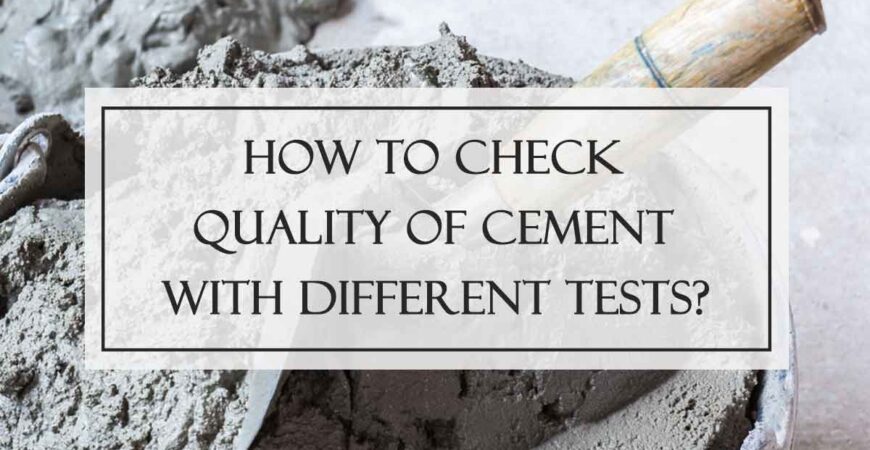Cement is made by mixing calcium, silica, aluminum, iron, and other components in a well-controlled chemical reaction. Limestone, shells, and chalk or marl, as well as shale, clay, slate, blast furnace slag, silica sand, and iron ore, are common ingredients in cement production.
Cement is a fundamental building element found in structures, sidewalks, and roads all over the world, and is an essential component of concrete and mortar. It’s vital that the cement is of good quality to avoid cracks and premature failure and to keep the project safe, robust, and long-lasting.
Many individuals mistakenly confuse the phrases — cement, concrete, and mortar. Concrete is a composite material that is manufactured by combining aggregates like sand, gravel, or crushed stone with a water-cement mixture. Mortar is a cement-and-fine-aggregate mixture that is used to hold bricks or other structural components together.
How to Check Quality of Cement?
There are various things to verify, some of which can be done on-site.
Standard grades of Ordinary Portland cement (OPC) are available. These grades can be specified throughout the purchase process. 33 Grade OPC is a good choice for general construction jobs in normal environmental conditions. 43 Grade OPC is apt for Home Building and is generally used for brickwork, foundations, plastering, and compound wall applications. For constructions like skyscrapers, bridges, runways, concrete roadways, and other heavy-duty construction applications, 53 Grade OPC provides early high strength and durability.
Once you’ve decided on the right cement grade for your project, make sure you get it from a reliable supplier. Purchase bags from a reputable manufacturer that has been machine-sewn.


● Packaging
Verify that the stitching is intact and that the bags do not have holes if purchased in a bag. To ensure that the cement meets production requirements, look for certification marks such as CE or ISI. Examine the bag’s manufacture date, which is printed on it. Cement’s strength deteriorates over time, so it’s best to utilize it as soon as possible after it’s made, ideally within 90 days. The strength of cement is reduced by 20-30% after three months, 30-40% after six months, and up to 40-50% after a year.
● Look and Feel
Grasp a handful of cement with your hands. By feeling and looking at the cement, you can make some good decisions. The cement should be free of lumps and dust, and it should be cool to the touch, suggesting that no hydration reaction is occurring. Take a look at the hue. Cement for building construction should be a uniform greenish-gray color, whereas decorative cement should be white.
● Water Tests
Quality cement that is free of impurities should float on the surface for a while before sinking when thrown into a bucket of water. To guarantee that the cement hardens properly, make a paste with some cement and water. Form the paste by hand, then set it aside for 24 hours in a pail of water. The cement should solidify and keep its shape once it has been applied.
● Smell
The cement may have too much clay and silt if it smells earthy.
● Strength
Form an 8 inch in 1 by 1 in then, with the block on six-inch-apart supports, place it under a 75-pound load. There should be no indicators of failure on the block.
You can be confident that your cement-based structure will be robust and durable for years if you follow these basic inspection suggestions.
Best Quality of Cement
After China, India is one of the two largest cement producers in the world. We have the capacity to generate over 151.2 million tonnes of cement, and India is home to numerous cement enterprises and brands. According to official data, India has roughly 185 cement facilities, most of which are located in Tamil Nadu, Rajasthan, and Andhra Pradesh.
Cement is divided into grades, which aid in calculating the concrete’s compressive strength. Almost every year, a new variety of cement outperforms the previous one in terms of breaking through barriers and meeting building deadlines.
Top 10 Branded Cements in India
- Ultra Tech Cement
- Shree Cement
- Ambuja Cement
- Ramco Cement
- JSW Cement
- Birlashakti Cement
- Dalmia Cement
- BirlaA1 Cement
- Nagarjuna Cement
- Sagar Cement
This article is about the best quality of cement in India, and these are the top brands that are best for home construction. As we all know, India is one of the world’s most populated countries, and it is constantly subjected to a variety of constructions. Choosing the appropriate cement will assist you in making the proper decision.
These are the greatest cement for constructing strong constructions.
Check This Out: Top 5 Different types of sand | Sources & Classification





